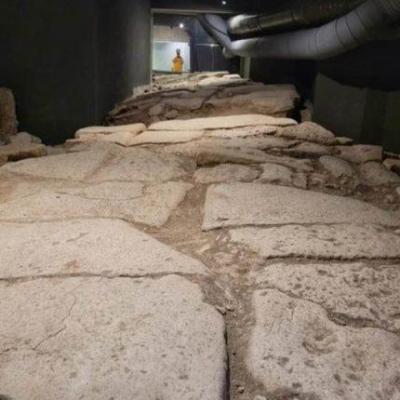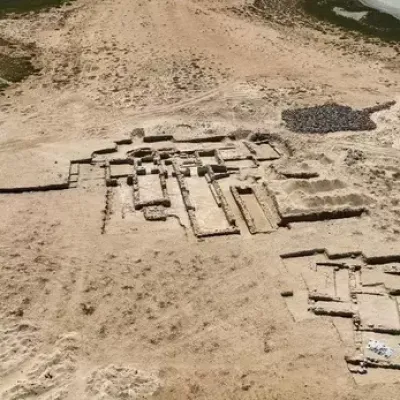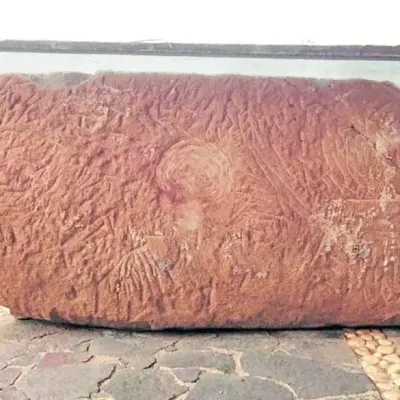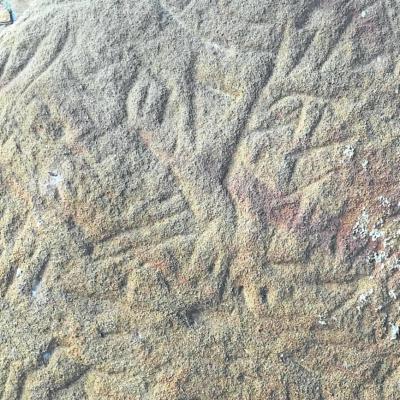INSTITUT SUPERIEUR D'ANTHROPOLOGIE
INSTITUTE OF ANTHROPOLOGY
ONLINE COURSES / COURS A DISTANCE
DEBUT COURS : FEVRIER 2023
REGISTER NOW
ROUMANIE –  Cluj-Napoca - The archaeologists of the National Museum of the History of Transylvania in Cluj-Napoca discovered a 2,000-year-old Roman road in the central area of the city, which was preserved in good condition. They explain the durability of these roads by the fact that they have been used for a long time and maintained. “Several fragments of a Roman road were found, covered with slabs and built of river stones, sometimes glued with mortar, at a depth of about 80 cm. The orientation of the road is north-south and it is probably related to the street network of the Roman city of Napoca”, said archaeologist Cristian Dima. The strength and durability of roads and other constructions made by the Romans is also due to the fact that they were reused and maintained later, but also to the Roman technology, which was advanced for that time. “They had pretty advanced technology for the time. They were doing the job pretty well. A fairly solid structure was made, with large stones at the base, then with small stones and then large slabs in the upper part, worked more or less. In Cluj, Feleac tiles were used, some of them rounded. On a smaller scale, it closely resembles what is preserved today in Pompeii. The resistance of the Roman constructions is due to a good extent to the mortar they invented then, but also to their subsequent reuse, whereby those who reused them took care to preserve them”, says the archaeologist. According to the researchers, the Romans produced a very resistant concrete by mixing lime and volcanic rock. Also, for underwater structures, lime was mixed with volcanic ash to form mortar, and this mortar was mixed with volcanic tuff and placed in wooden molds, and the water activated a hot chemical reaction. The water molecules entered the structure of the lime, and it reacted with the ash in such a way that the entire material was cemented.
Cluj-Napoca - The archaeologists of the National Museum of the History of Transylvania in Cluj-Napoca discovered a 2,000-year-old Roman road in the central area of the city, which was preserved in good condition. They explain the durability of these roads by the fact that they have been used for a long time and maintained. “Several fragments of a Roman road were found, covered with slabs and built of river stones, sometimes glued with mortar, at a depth of about 80 cm. The orientation of the road is north-south and it is probably related to the street network of the Roman city of Napoca”, said archaeologist Cristian Dima. The strength and durability of roads and other constructions made by the Romans is also due to the fact that they were reused and maintained later, but also to the Roman technology, which was advanced for that time. “They had pretty advanced technology for the time. They were doing the job pretty well. A fairly solid structure was made, with large stones at the base, then with small stones and then large slabs in the upper part, worked more or less. In Cluj, Feleac tiles were used, some of them rounded. On a smaller scale, it closely resembles what is preserved today in Pompeii. The resistance of the Roman constructions is due to a good extent to the mortar they invented then, but also to their subsequent reuse, whereby those who reused them took care to preserve them”, says the archaeologist. According to the researchers, the Romans produced a very resistant concrete by mixing lime and volcanic rock. Also, for underwater structures, lime was mixed with volcanic ash to form mortar, and this mortar was mixed with volcanic tuff and placed in wooden molds, and the water activated a hot chemical reaction. The water molecules entered the structure of the lime, and it reacted with the ash in such a way that the entire material was cemented.
https://www.romaniajournal.ro/society-people/science/2000-year-old-roman-road-discovered-in-the-center-of-cluj-napoca/
ECOSSE –  Cracknie - Graeme Cavers and his team of archaeologists set off in search of a mysterious underground passage called a souterrain. There are around 500 of these Iron Age structures scattered throughout the Scottish Highlands, but nobody knows what they were built for, and no one has ever discovered one intact. “Perhaps they were for security, keeping valuables safe, or slaves or hostages secure. Or perhaps they were for ceremonial purposes, for household rituals, like a medieval shrine or private chapel
Cracknie - Graeme Cavers and his team of archaeologists set off in search of a mysterious underground passage called a souterrain. There are around 500 of these Iron Age structures scattered throughout the Scottish Highlands, but nobody knows what they were built for, and no one has ever discovered one intact. “Perhaps they were for security, keeping valuables safe, or slaves or hostages secure. Or perhaps they were for ceremonial purposes, for household rituals, like a medieval shrine or private chapel
http://prehistoricarch.blogspot.com/2023/01/lasers-are-mapping-scotlands-mysterious.html
UAE –  Al Sinniyah - Cette langue aride et ensablée ravit en revanche les archéologues des Émirats arabes unis. Ils y ont mis au jour, ces derniers mois, des vestiges pour le moins inattendus dans cette partie du monde : un monastère chrétien. Selon les premières datations réalisées sur les vestiges découverts sur place, le complexe religieux aurait été fondé entre la fin du VIe et le début du VIIe siècle. Cela en ferait un site qui précède de quelques dizaines d'années la naissance et la diffusion de l'Islam dans la péninsule arabique, voire qui en serait contemporain. Le fait qu'il y ait eu une population arabe chrétienne en Arabie orientale a été un peu oublié. Cette découverte est donc un rappel important d'un chapitre perdu de l'histoire arabe. Le site religieux était composé d'une église à nef unique, de cellules et d'un réfectoire. Une résidence privilégiée, une maison à cour, qui devait accueillir le responsable de la communauté a aussi été mise au jour. Des structures liées à la vie quotidienne - citernes, fours, espaces de stockage… - complétaient le tout. Parmi les éléments les plus remarquables, les chercheurs révèlent avoir identifié de possibles fonts baptismaux près de l'autel, ainsi que les vestiges de larges calices en verre sans doute d'anciennes coupes liturgiques, pour l'Eucharistie. Les vestiges les plus récents du site dateraient du milieu du VIIIe siècle, de la fin du Califat omeyyade, dont l'emprise s'étendait de la façade atlantique à la vallée de l'Indus. «La communauté n'a pas fait l'objet d'une conquête violente, mais a été lentement abandonnée», pointe néanmoins Tim Power, qui indique que les archéologues n'ont pas mis en évidence de traces de destruction violente du monastère. Le monastère d'Al Sinniyah est le second établissement chrétien de ce genre découvert aux Émirats arabes unis depuis les années 1990, et le sixième autour du golfe Persique. À quelques centaines de mètres du monastère, les vestiges de deux villages ont également été fouillés par les chercheurs. Le premier avait été détruit par les Britanniques en 1820. Le second datait de l'époque préislamique.
Al Sinniyah - Cette langue aride et ensablée ravit en revanche les archéologues des Émirats arabes unis. Ils y ont mis au jour, ces derniers mois, des vestiges pour le moins inattendus dans cette partie du monde : un monastère chrétien. Selon les premières datations réalisées sur les vestiges découverts sur place, le complexe religieux aurait été fondé entre la fin du VIe et le début du VIIe siècle. Cela en ferait un site qui précède de quelques dizaines d'années la naissance et la diffusion de l'Islam dans la péninsule arabique, voire qui en serait contemporain. Le fait qu'il y ait eu une population arabe chrétienne en Arabie orientale a été un peu oublié. Cette découverte est donc un rappel important d'un chapitre perdu de l'histoire arabe. Le site religieux était composé d'une église à nef unique, de cellules et d'un réfectoire. Une résidence privilégiée, une maison à cour, qui devait accueillir le responsable de la communauté a aussi été mise au jour. Des structures liées à la vie quotidienne - citernes, fours, espaces de stockage… - complétaient le tout. Parmi les éléments les plus remarquables, les chercheurs révèlent avoir identifié de possibles fonts baptismaux près de l'autel, ainsi que les vestiges de larges calices en verre sans doute d'anciennes coupes liturgiques, pour l'Eucharistie. Les vestiges les plus récents du site dateraient du milieu du VIIIe siècle, de la fin du Califat omeyyade, dont l'emprise s'étendait de la façade atlantique à la vallée de l'Indus. «La communauté n'a pas fait l'objet d'une conquête violente, mais a été lentement abandonnée», pointe néanmoins Tim Power, qui indique que les archéologues n'ont pas mis en évidence de traces de destruction violente du monastère. Le monastère d'Al Sinniyah est le second établissement chrétien de ce genre découvert aux Émirats arabes unis depuis les années 1990, et le sixième autour du golfe Persique. À quelques centaines de mètres du monastère, les vestiges de deux villages ont également été fouillés par les chercheurs. Le premier avait été détruit par les Britanniques en 1820. Le second datait de l'époque préislamique.
https://www.lefigaro.fr/culture/patrimoine/un-monastere-chretien-medieval-chapitre-perdu-de-l-histoire-arabe-exhume-sur-une-ile-pres-de-dubai-20230121
FRANCE -  Amiens - La zone concernée par ce diagnostic se trouve dans le quartier Saint-Acheul, à proximité immédiate de la carrière Tellier. Un sondage a permis la découverte, entre 2,80 et 3 mètres de profondeur, de quatre artefacts paléolithiques remaniés dans les sédiments fluviatiles attribués à la nappe de La Garenne. Ils témoignent d'une fréquentation de ce secteur vers - 450/400 000 ans par Homo heidelbergensis.
Amiens - La zone concernée par ce diagnostic se trouve dans le quartier Saint-Acheul, à proximité immédiate de la carrière Tellier. Un sondage a permis la découverte, entre 2,80 et 3 mètres de profondeur, de quatre artefacts paléolithiques remaniés dans les sédiments fluviatiles attribués à la nappe de La Garenne. Ils témoignent d'une fréquentation de ce secteur vers - 450/400 000 ans par Homo heidelbergensis.
https://www.associationciras.fr/blog
FRANCE –  Le Bosquel - Ce diagnostic complète les observations archéologiques réalisées au cours des deux opérations réalisées par L. Duvette en 2011 et 2014. Trois fosses charbonneuses, réparties dans un rayon de 25 à 30 m, ont livré, pour l'une d'elle, des esquilles osseuses (faune ? humain?) dont l'une a pu être datée par C14 du Néolithique Moyen II. Une occupation de l’âge du Bronze est attestée par un silo qui a notamment livré une moitié de peson et un fragment de meule en grès. Il pourrait éventuellement être associé à un puits. Quelques éléments de la Tène ancienne sont localisés sur deux zones espacées de 200 m. La première est matérialisée par une fosse et un fossé parcellaire suivi environ 125 m, la seconde, par deux fosses et deux trous de poteau. Une sépulture à incinération de la Tène moyenne, préservée, sur 6 cm de profondeur, a livré, outre l'amas osseux, trois fonds de vases. Le tracé d’un enclos (habitat ou parcellaire), partiellement reconnu (minimum 9000 m²) peut être daté de la protohistoire récente. Les indices ferreux témoignent de la forte probabilité de la pratique d’activités de forge. Les vestiges de la période romaine (mi IIe-mi IIIe siècle) se concentrent en limite de la chaussée Brunehaut sur une bande comprise entre 30 m et 85 m de largeur sur une longueur de 450 mètres. Complétant les indices mis en évidence lors des précédents diagnostics, ils comprennent un enclos partiellement dégagé, un four et sa fosse associée, deux bâtiments et des espaces de circulation. La fonction particulière de ce relais routier est renforcée par la découverte de gros blocs calcaires qui témoignent de l’existence de bâtiments publics imposants.
Le Bosquel - Ce diagnostic complète les observations archéologiques réalisées au cours des deux opérations réalisées par L. Duvette en 2011 et 2014. Trois fosses charbonneuses, réparties dans un rayon de 25 à 30 m, ont livré, pour l'une d'elle, des esquilles osseuses (faune ? humain?) dont l'une a pu être datée par C14 du Néolithique Moyen II. Une occupation de l’âge du Bronze est attestée par un silo qui a notamment livré une moitié de peson et un fragment de meule en grès. Il pourrait éventuellement être associé à un puits. Quelques éléments de la Tène ancienne sont localisés sur deux zones espacées de 200 m. La première est matérialisée par une fosse et un fossé parcellaire suivi environ 125 m, la seconde, par deux fosses et deux trous de poteau. Une sépulture à incinération de la Tène moyenne, préservée, sur 6 cm de profondeur, a livré, outre l'amas osseux, trois fonds de vases. Le tracé d’un enclos (habitat ou parcellaire), partiellement reconnu (minimum 9000 m²) peut être daté de la protohistoire récente. Les indices ferreux témoignent de la forte probabilité de la pratique d’activités de forge. Les vestiges de la période romaine (mi IIe-mi IIIe siècle) se concentrent en limite de la chaussée Brunehaut sur une bande comprise entre 30 m et 85 m de largeur sur une longueur de 450 mètres. Complétant les indices mis en évidence lors des précédents diagnostics, ils comprennent un enclos partiellement dégagé, un four et sa fosse associée, deux bâtiments et des espaces de circulation. La fonction particulière de ce relais routier est renforcée par la découverte de gros blocs calcaires qui témoignent de l’existence de bâtiments publics imposants.
https://www.associationciras.fr/blog
PHILIPPINES – 
 Visayas - In the Philippines, there are two known ancient petroglyph sites. These are the Angono-Binangonan Petroglyphs in Rizal Province and the Alab Petroglyphs in Bontoc, Mountain Province. The Rizal site dates probably to the late Neolithic Period (6,000 BC-2,000 BC), while that of Bontoc, carved on boulders on Data plateau, date to around 1,500 BC or later. Known as the oldest work of art in the country, the Angono-Binangonan Petroglyphs, composed of anthropomorphic and zoomorphic figures, were engraved using crude tools, while those of Alab, about 200 geometrical drawings resembling female sex organs and associated with fertility, were made using metal implements. A recent check by this writer on the petroglyphs reveal startling details which give possible clues on what the carved ensemble is all about, and the possible use of the area where it was discovered. Largely abstract, the petroglyphs occupy one side of the sandstone boulder measuring 26 inches in height and 63 inches long, with a thickness of 16 inches.It has a central circular figure which could be interpreted as the sun surrounded by random lines. An astonishing feature is an image on its left portion resembling a person with hands raised towards the direction of the central figure.The standing image could represent a babaylan or spirit medium performing a ritual. In ancient Visayan society, a babaylan is either a male or female, or even those called asog or transvestites. Ancient Visayans were also known to worship the sun and the moon, particularly its new moon phase. The surprises did not end there, as another discovery was made recently inside the same property. That discovery was a lithic, a possible stone tool partly buried at the base of a rocky outcrop. This artifact was first thought to be a portion of a burial jar or part of a human skull. This latest discovery, which can be theoretically dated to the Neolithic Period, is a bit concave in shape with the other side resembling, most likely, a phallus. It also has a naturally smooth outer edge, and sharp edges except for the handle. It was probably used by a left-handed person with a depressed portion for the thumb.Apart from possibly being a ritual site, the area could also be a hunting ground, where the artifact was utilized either as a scraper for animal meat, to chop off fruits or vegetables, or to get the meat out of a fruit such as a coconut.
Visayas - In the Philippines, there are two known ancient petroglyph sites. These are the Angono-Binangonan Petroglyphs in Rizal Province and the Alab Petroglyphs in Bontoc, Mountain Province. The Rizal site dates probably to the late Neolithic Period (6,000 BC-2,000 BC), while that of Bontoc, carved on boulders on Data plateau, date to around 1,500 BC or later. Known as the oldest work of art in the country, the Angono-Binangonan Petroglyphs, composed of anthropomorphic and zoomorphic figures, were engraved using crude tools, while those of Alab, about 200 geometrical drawings resembling female sex organs and associated with fertility, were made using metal implements. A recent check by this writer on the petroglyphs reveal startling details which give possible clues on what the carved ensemble is all about, and the possible use of the area where it was discovered. Largely abstract, the petroglyphs occupy one side of the sandstone boulder measuring 26 inches in height and 63 inches long, with a thickness of 16 inches.It has a central circular figure which could be interpreted as the sun surrounded by random lines. An astonishing feature is an image on its left portion resembling a person with hands raised towards the direction of the central figure.The standing image could represent a babaylan or spirit medium performing a ritual. In ancient Visayan society, a babaylan is either a male or female, or even those called asog or transvestites. Ancient Visayans were also known to worship the sun and the moon, particularly its new moon phase. The surprises did not end there, as another discovery was made recently inside the same property. That discovery was a lithic, a possible stone tool partly buried at the base of a rocky outcrop. This artifact was first thought to be a portion of a burial jar or part of a human skull. This latest discovery, which can be theoretically dated to the Neolithic Period, is a bit concave in shape with the other side resembling, most likely, a phallus. It also has a naturally smooth outer edge, and sharp edges except for the handle. It was probably used by a left-handed person with a depressed portion for the thumb.Apart from possibly being a ritual site, the area could also be a hunting ground, where the artifact was utilized either as a scraper for animal meat, to chop off fruits or vegetables, or to get the meat out of a fruit such as a coconut.
https://lifestyle.inquirer.net/438710/potential-prehistoric-petroglyph-site-discovered-in-visayas-approved/#ixzz7rF2DxrAi
TURQUIE –  Klazomenai - A seal belonging to the city was found for the first time during excavations in the ancient city of Klazomenai in the Urla district of Izmir in western Turkey. Excavation Director Professor Yaşar Ersoy said: “ We found a 2,400-year-old seal made of clay engraved with the Greek sun god Apollo from the 4th century BC.” Klazomenai Archaeological Site, whose remains are partly located on Quarantine Island, is one of the twelve Ionian cities. The Klazomenai olive oil workshop, which is one of the earliest workshops in the Aegean region that has survived so far, shows the existence of mass production in ancient times. It is dated to the sixth century B.C. And it is the ceramic production center of the ancient period. This seal is the first example. Because we know of vases that were sealed with seals created from coins associated with the city, but the seal was never found. We can say that the first seal of the city was found. B.C. It’s a 2,400-year-old seal from the 4th century,” he said.
Klazomenai - A seal belonging to the city was found for the first time during excavations in the ancient city of Klazomenai in the Urla district of Izmir in western Turkey. Excavation Director Professor Yaşar Ersoy said: “ We found a 2,400-year-old seal made of clay engraved with the Greek sun god Apollo from the 4th century BC.” Klazomenai Archaeological Site, whose remains are partly located on Quarantine Island, is one of the twelve Ionian cities. The Klazomenai olive oil workshop, which is one of the earliest workshops in the Aegean region that has survived so far, shows the existence of mass production in ancient times. It is dated to the sixth century B.C. And it is the ceramic production center of the ancient period. This seal is the first example. Because we know of vases that were sealed with seals created from coins associated with the city, but the seal was never found. We can say that the first seal of the city was found. B.C. It’s a 2,400-year-old seal from the 4th century,” he said.
Klazomenai, ceramic center of ancient period was found the first seal belonging to the city - Arkeonews